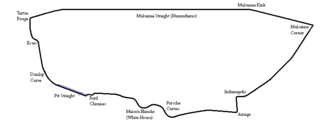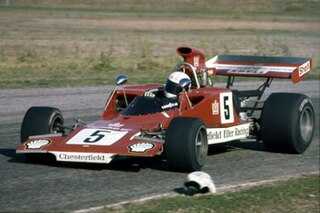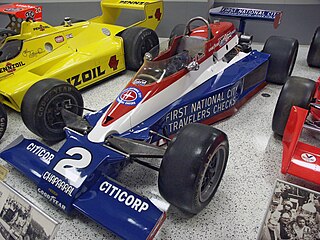
The 1975 24 Hours of Le Mans was the 43rd Grand Prix of Endurance, and took place on 14 and 15 June 1975. Colloquially called the “Le Mans Economy Run”, stringent refuelling regulations were put in place. Unable to match the requisite 7mpg fuel economy the manufacturer teams from Ferrari, Alfa Romeo withdrew and Matra had retired from the sport at the end of 1974. Therefore, this only left Gulf and Ligier as front-running works-teams.
The Lola T610 was a ground effect Group C sports prototype race car, designed, developed and built by British manufacturer Lola, for sports car racing, specifically the IMSA GTP Championship, World Sportscar Championship and 24 Hours of Le Mans, between 1982 and 1984. A total of two models were produced.

The Lola T290, and its evolutions, the T292, T294, T296, T297, T298, and T299, are a series of Group 5 Sports 2000 prototype race cars, designed and developed by Bob Marston, John Barnard, Patrick Head, and Eric Broadley, and built by British manufacturer and constructor Lola, for European 2-Litre Championship sports car racing series, between 1972 and 1981.

The Lola T330 was an open-wheel formula race car, designed, developed and built by Lola Cars, for Formula 5000 racing, in 1973.

The Lola T430 is an open-wheel formula race car, designed, developed and built by British manufacturer and constructor Lola Cars, for Formula 5000 racing, in 1976.

The Lola T190 was an open-wheel formula race car, designed, developed and built by Lola Cars, for Formula 5000 racing, in 1969. A total of 17 models were produced.

The Lola T300 was an open-wheel formula race car, designed, developed and built by Lola Cars, for Formula 5000 racing, in 1971.
The Lola T150, and it's the derivatives, the T152 and T153, were open-wheel racing car chassis, designed and built by Lola Cars to compete in USAC IndyCar racing series, between 1968 and 1970. The T150 and T153 were powered by the 159 cu in (2.61 L) 780–900 hp (580–670 kW) Ford Indy V-8 turbo engine; while the T152 chassis used a 159 cu in (2.61 L) 900 hp (670 kW) Offenhauser 4-cylinder turbo engine. Both the T150 and T152 used a unique four-wheel-drive system, which would be banned after the 1969 season. The T153 only used a conventional two-wheel-drive (rear-wheel-drive setup. The different chassis would, over the span of three years, win a total of 9 races, all while being driven by Al Unser.
The Lola T530 is a purpose-built Can-Am sports prototype, designed by British manufacturer Lola Cars in for the revived Can-Am series 1980. It was very successful, winning 7 of the 9 races in its first season of competition alone, and gave Patrick Tambay the championship with Carl A. Haas racing Team. Geoff Brabham won the championship in 1981; despite only winning 2 races. It was used in Can-Am racing until 1983. It was later used in the international Interserie racing series, and the British Thundersports racing series, between 1984 and 1988. Between 1980 and 1988, it scored a total of 32 race wins, and 43 podium finishes; a very impressive tally indeed. As with all other full-size Can-Am cars of the time, it used a mid-mounted 5-liter, naturally-aspirated, Chevrolet V8 engine. A total of 10 chassis' were built.

The Lola T500 is an open-wheel racing car chassis, designed, developed and built by Lola Cars, that competed in the CART open-wheel racing series, for competition in the 1978, 1979, and 1980 USAC Championship Car seasons. It was powered by the 840 hp (630 kW) Ford-Cosworth DFX. Only 5 models were produced. It won a total of 3 races, all in 1978, including the famous and prestigious 1978 Indianapolis 500, being driven by Al Unser.
The Lola B01/00 is an open-wheel racing car chassis, designed and built by Lola Cars that competed in the CART open-wheel racing series, for competition in the 2001 season. It scored a total of 10 race wins that season, with Swede Kenny Bräck eventually finishing in second place, as runner-up in the championship, with 163 points in this car.

The Lola T210, and its evolution, the Lola T212, are Group 6 sports prototype race cars, designed, developed and built by British manufacturer Lola, for the newly created European 2-Litre sports car racing championship, in 1970.
The Lola T220, and its evolution, the Lola T222, are Group 7 sports prototype race cars, designed, developed, and built by the British manufacturer and constructor Lola, to compete in the Can-Am championship from the 1971 season. It also took part in the European Interserie championship.
The Lola T390 is a 2-litre Sports 2000 prototype race car, designed, developed and built by British manufacturer Lola, for 2-litre sports car racing, in 1975.
The Lola T120, also known as the BMW G767, was a Group 7 sports prototype race car, designed, developed and built by British manufacturer Lola, specifically to compete in hill climb racing, in 1967. It was powered by a unique 2-liter, 16-valve, four-cylinder engine, designed by Ludwig Apfelbeck, to produce between 260 and 280 hp @ 8500 rpm, and was itself based on the M10 engine.
The Lola T490 is a 2-litre Group 5 Sports 2000 prototype race car, designed, developed and built by British manufacturer Lola, for 2-litre sports car racing, in 1977.
The Lola T590, and its evolutions, the Lola T592, the Lola T592S, the Lola T594, the Lola T594C, the Lola T596, the Lola T596C, the Lola T598, and the Lola T598C, are a series of Sports 2000 and C Sports prototype race cars, designed, developed and built by British manufacturer Lola, for sports car racing, in 1980.
The Lola T54 was an open-wheel formula race car, designed, developed, and built by British manufacturer Lola Cars, for Formula Two racing, in 1964.
The Lola T87/50 is an open-wheel formula race car chassis, designed, developed and built by British manufacturer Lola, for use in the International Formula 3000 series and the Japanese Formula 3000 series, a feeder series for Formula One, in 1987.
The Lola T110 was a Group 6 and Group 7 sports prototype race car, designed, developed, and built by British manufacturer Lola, specifically to compete in hill climb racing briefly alongside the T120, in 1967. It was powered by a 2.0 L (120 cu in) BMW Apfelbeck straight-four engine.








